LISA technology: Interferometry explained
Gravity underpins some of the most exotic and extreme phenomena in the Universe: forming galaxies, exploding stars, merging black holes. Such phenomena are so intensely energetic that they can cause the very fabric of space-time to ripple, creating gravitational waves.
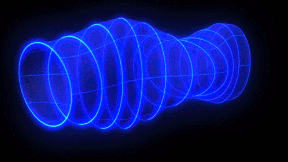 |
| Gravitational waves. Credit: ESA–C.Carreau |
These waves are incredibly difficult to detect as they are not observable using electromagnetic light, travel immense distances without interacting, and have very subtle effects when they do so. In fact, currently detectable waves would only displace a one-metre bar by just one-tenth of a zepto-metre – a minuscule one ten-millionth of the size of a single proton.
However, ground-based observatories – the US-based Laser Interferometer Gravitational-Wave Observatory (LIGO) and the European Virgo observatory – have shed light on these waves in recent years using a technique known as laser interferometry. This will be used for the first time to hunt for gravitational waves in space by LISA, the Laser Interferometer Space Antenna, when it launches in 2034.
LISA will employ a technique known as interferometry. As the name suggests, an interferometer can be seen as an 'interference meter' – a way to detect, monitor, and measure the 'interference pattern' that arises when two beams of light are shifted in phase with respect to one another (meaning that they are at different points of their cycle at a given time). While other types of interferometers look for changes in the alignment or position of light beams, for the detection of gravitational waves, interferometers such as LIGO, Virgo and LISA look for changes in 'arm' length: beams that are stretched or compressed in relation to another as a result of an interaction with a gravitational wave.
Interferometers split the light from a laser into two perpendicular paths (or 'arms'). These beams travel away from the beamsplitter, are reflected back, and reconvene at the detector. If both arms are exactly the same length, these beams come back together and superimpose to completely cancel each other out such that no light reacts the detector ('destructive interference'). However, if one beam ends up travelling a slightly longer distance than its companion, the returning waves will arrive slightly offset and fail to cancel each other out completely, causing some light – an interference pattern – to arrive at the detector.
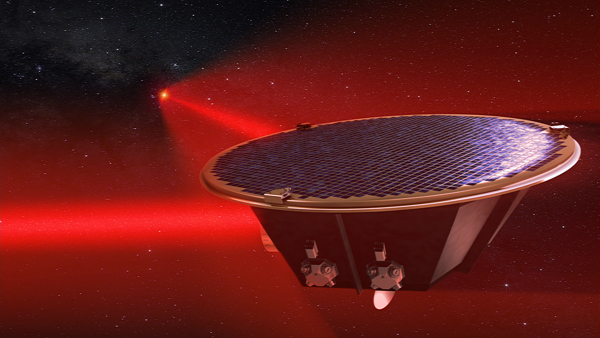 |
| LISA mission concept. Credit: AEI/Milde Marketing/Exozet |
In LISA's case, this technique will rely upon measuring how different masses move relative to one another, and how they are displaced by surrounding forces and disturbances (in this case, gravity). LISA will carry multiple masses placed in free-fall, enclosed in separate, drag-free spacecraft to ensure that their motion and behaviour is determined solely by gravity. Each spacecraft will carry two test masses, and will beam a laser to the other two spacecraft to precisely measure the positions of the other masses via interferometry. The same technique is used by LIGO, only with non-free-floating masses in the form of large mirrors hung in multi-stage pendulums.
LISA differs somewhat from the aforementioned description of an interferometer: whereas ground-based observatories such as LIGO and Virgo use mirrors to reflect beams back to the origin, this cannot be done in space due to the immense distances involved. Instead, LISA will essentially simulate a mirror by creating a new beam with its own lasers, phase-locking it with the incoming beam, and sending it back to the origin.
The mission will comprise three individual spacecraft that will trail behind Earth; this trio will create a triangular formation with an inter-spacecraft separation of 2.5 million km, and maintain their formation even though each spacecraft is in a separate orbit around the Sun. As the orientation and direction of motion of the spacecraft triangle changes along the orbit, it will be possible to determine the direction of incoming gravitational wave sources.
In order for any displacements or minute changes in position to be measurable, scientists need a 'quiet' environment in which to observe these waves. This is something that ESA tested in 2016–2017 with LISA Pathfinder. This mission performed the first high-precision laser interferometric tracking of free-falling bodies in space, and demonstrated that it was possible to monitor them precisely enough to determine subtle differences in position of less than a trillionth of a metre.
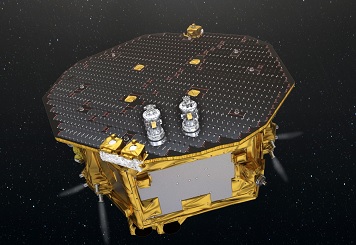 |
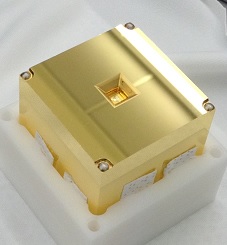 |
| LISA Pathfinder operating in space. Credit: ESA/ATG medialab | LISA Pathfinder test mass. Credit: CGS SpA |
LISA Pathfinder carried two identical test masses: two cubes of gold:platinum alloy. The satellite minimised outside disturbances – pressure due to sunlight, incoming solar wind particles, micrometeoroids, and more – to keep the masses still and create an internal cavity free from electrical, magnetic, and thermal forces as far as possible: the most 'silent' place in the Solar System, or the quietest place in space. This ensured that the test masses were only moving due to gravity and nothing else, something that is crucial in the exploration of the gravitational Universe.
The mission successfully proved that its innovative technologies were able to reduce external influences on free-falling tests masses such that their relative motions could be measured with unprecedented accuracy, achieving a precision far higher than originally predicted: 300 and 15 times better than required for displacement and differential acceleration, respectively.
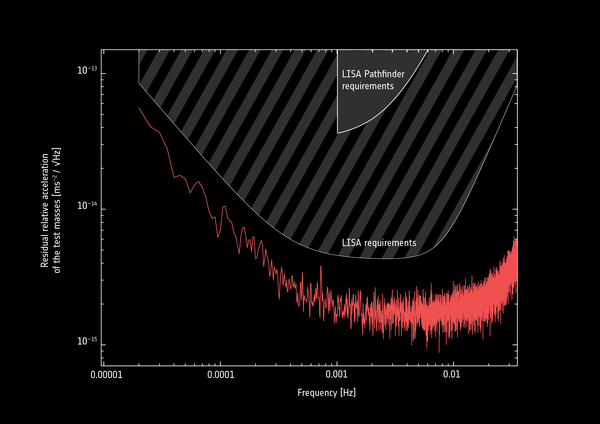 |
| LISA Pathfinder performance analysis. Credit: ESA/LISA Pathfinder Collaboration |
As the first dedicated space-based gravitational wave observatory, LISA will build upon the pioneering technology tested by LISA Pathfinder to detect low-frequency gravitational waves. To achieve this, LISA will carry an advanced payload: a 30-cm telescope to emit laser light, and a Gravitational Reference Sensor (GRS) within each spacecraft which will contain the free-falling test masses. Laser interferometry will be used to monitor the motion of the test mass with respect to the satellite, and from one satellite to the other at the opposite end of the arm.
While ground-based observatories can explore high-frequency waves emanating from cosmic objects such as black holes of up to 100 times the mass of the Sun (with frequencies of 10–1000 Hz), they are limited by the 'noisy' environment of Earth, and cannot probe the lower frequency fluctuations produced by more massive objects. In space, far from troublesome seismic noise, LISA will be able to probe down to frequencies of 0.1 mHz, to detect waves coming from colossal objects such as merging supermassive black holes at the cores of massive galaxies.
